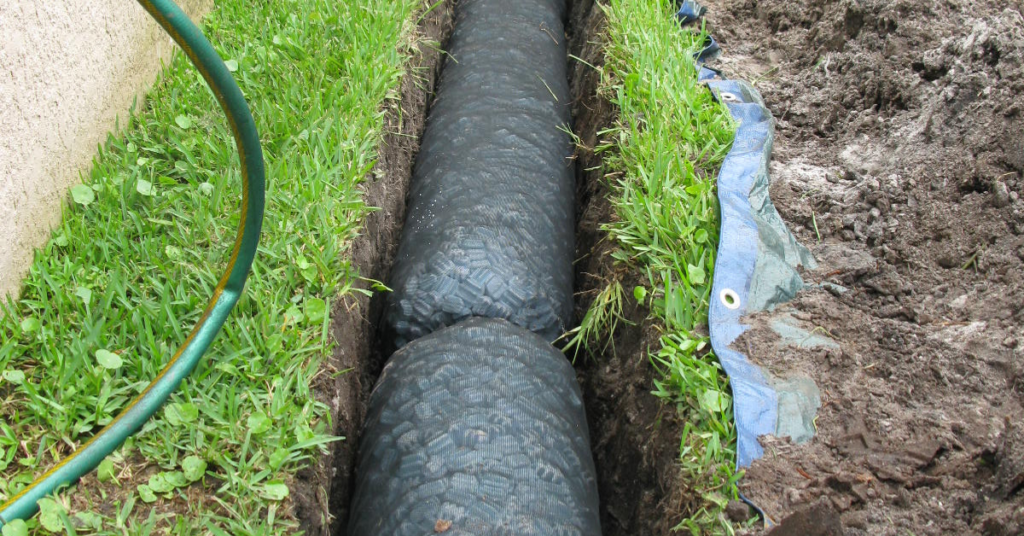How to Build a French Drain for Yard Drainage
french drain diagram the French drain for yard drainage is the most effective drainage system. Any homeowner can use in order to deal with water collection within his compound. Regardless, if it is water accumulated in your yard. Or water collected in the basement or some other area. The French drain is a solution which is applicable here. It is a basic design that prevents water from coming close to your foundation. And at the same time enhances the outlook of the lawn.. Here, you will learn how to build your French drain in detail, and we’ll explain the various aspects of an explanation. Such as the project in a simple French drain diagram. It’s time to set the next steps of the lawn becoming dry but healthy !
1. Understanding the Concept of a French Drain
A French drain is a gravel or rock-filled trench with a pipe. Having small holes to disperse water. At a required space that is away from the basements or the yards. The system is normally applied to mitigate water stagnation especially around the foundation or in areas. Where the ground is known to be highly saturated. It needs one to have an understanding of the procedure followed in a French drain project.
In the French drain diagram the trench is illustrated. With a slope whereby it will be required to possess. In order that water movement is towards the intended area of drainage. You will also see that the diagram shows the position of the pipe, the gravel and mesh. If it should be necessary to protect the drain against debris. There are some basement French drain diagrams. Which are designed to keep the basement flooded and some are yard French drain diagrams used to drain lawns.
2. Why Choose a French Drain for Yard Drainage?
It is also used in the areas where there is collection of water on the yard. Or around the foundation of the building. The greatest advantage is its capacity to pass water from regions of concerns. When your lawn becomes wet after rain or during the rainy season, a French drain allows you to sump it away. You do not have to worry where the water. Which makes its way into your compound goes, say to the drainage. Well or another drainage system that is in your compound.
In this process of installing a yard French drain. You are also saving the grass and the surrounding ground from erosion brought about by continued accumulation of water. For basements, a basement French drain diagram depicts the manner of laying of the French drain. Around the basement to help in preventing floods. This means that in case of water seepage groundwater is well channeled to avoid negative impacts on your foundation. And to prevent water from getting to your basement.
3. Step-by-Step Process to Build a French Drain
The things you will have to collect include the perforated piping, gravel, landscape fabric. And other accessories like shovel, level, and measuring tape among others. The next thing to do is to determine the layout of where the French drain will be made.
- Mark Your Drainage Path – Try measuring the place where you will be laying your drain. And the angle of inclination not greater than ¼ inch per foot is most ideal. In this case, a French drain layout would be useful for visual purposes to ensure. That water will be channeled in the right manner.
- Digging the Trench – The trench should be around 6 to 12 inch wide. And should also be a minimum of 18 to 24 inch deep depending on the use. In case you are working with a French drain system diagram, this depth also makes the pipe to be laid below the ground. Where it drains the water effectively.
- The Pipe – This pipe should be installed into the gravel following the pattern pointed in the following steps below. The former means for example require the holes in the pipe to be placed downwards to. Allow the water into the pipe to be done keenly. However, if you are creating an interior French drain diagram it is done in a slightly inclined manner in the interior of the basement walls or foundation.(Amazon)
4. Creating Your Own French Drain Diagram
It is very important to have a diagram of the French drain so as to enable one to. Know the location of each part of the drain system. can use different software programs available in the markets to draw OH&S plans even without the help of professionals. On the paper, draw a rough plan of the yard or the basement and indicate. The area that floods or has high water accumulation. Subsequently, sketch the trajectory of the trench and mark where the pipe and gravel will be laid.
For instance, a yard French drain map simply illustrates the drain coursing. Through the edge of the yard, or area that has water problems. The diagram should have a slope which is important to allow for proper water run-off away from the home. In a basement French drain diagram, the drain will be located around the basement foundation. So that water will not be able to infiltrate your home.
A French drain system diagram will put in place a well-laid down plan of the drainage system. Expected and this helps in avoiding instances where wrong mistakes are made which would affect its functioning.

5. Selecting the Right Location for Your French Drain
An important aspect regarding the use of this type of system is that. Its location must be strategic for optimum results. In fact, your drain should be installed where there is water accumulation. Like at the base of the outdoor space or where water usually pools after rainfall. This is needed to make sure that the area centered on the French drain has a right slope. Usually an inch per ten feet so that the liquids will drain.
In the case of a basement French drain, the drain should be placed alongside the walls. Within the basement and then channel the water to the sump pump or outside drainage system. When installing the yard drain, it should be preferably installed in the areas that are usually flooded or in the vicinity of the garden beds.
6. How to Dig the Trench for Your French Drain
Excavation work, especially while digging the trench required for the French drain, is one of the most tedious processes during construction . It is therefore very important to get the dimensions that are needed as well as the slope of the apparatus for it to perform to the best.
You should dig a trench that has a depth of about 45 cm to about 60 cm. When you are constructing the pros system around your house, make sure the French drain is sloped away from the house. In order to control drainage, the slope of a french drain can be designed by using a diagram. Make a straight and stable trench, and ensure that the sloping direction is consistent and continuously leading towards the place where the water is expected to be drained.(Visit website for more)
7. Installing the French Drain and Proper Drainage Materials
Once you are set to lay your drain after having dug a trench it is time to go for the best materials. A perforated pipe to let water pass through smoothly through the system should also be provided. The gravel is useful in countering the water flowing through the trench and the pipe.
Make sure that if you are installing French drain according to the French drain system diagram then position the pipe properly and surround it with gravel so that water could pass through it effectively. There should be access to running water since water is used frequently through the day for mop washing among other uses; second, the floor must be easily cleanable to prevent clogging, and third, for an outside kitchen, there should be a preparation area of soil or turf. For an interior French drain diagram, one may also require installing a sump pump at a lower end of the drain to transport water away from the foundation.
8. Maintenance Tips to Keep Your French Drain Working
After the French drainage has been installed in your home, it is best to ensure that you maintain It in order to have a good working drainage for many years. This should be checked frequently for blockage or any signs of wear most especially after several rains.
Conclusion
Altogether, the construction of the French drain for the yard drainage is the best way to solve water issues for your home or garden. By following the steps given above it is easy to install a drainage system that will prevent water flow to your foundation or flooding on the areas in the compound that you do not want. More importantly, explaining each of the parts of the French drain and the use of a French drain layout will make the flow of installation easier and efficient. No matter the kind of French drain you are working on: the yard French drain, the interior French drain, or the basement French drain, some vital factors that should be paid attention to include; the drainage plans, measurement and the materials to be used.
It is therefore evident that French drain installation in a well positioned location and proper maintenance could have solved all these problems although I am not sure how it works. The regular maintenance will make the drainage system to be in good condition and function as required so as not to compromise the structure of the home and property. If armed with adequate information, this is probably a task which you can comfortably handle to enjoy the benefits of a well-drained yard or a basement in the long run.
Key Points:
- They are specially useful in moving water away from foundations, basements and even yards.
- Other major constituents are perforated pipe, gravel base layer and fabric layer.
- A drawing of the French drain is crucial since it enables the contractor to understand how the French drain will work and how water is supposed to flow within the system.
- Installation involves digging a trench, laying a layer of gravel and then placing a pipe with holes in it and s Pope’s theory of the perforated pipe at a gradient of 1: 80.
- General maintenance and inspection are required to avoid such blockages and to make the pipes last long.
Excavating a French drain may sound like quite a difficult project, but it is actually quite an accessible job that one can undertake and avoid possibly causing great loss in the future. Using the French drain system diagram below and with your own patience, there is no reason why your home cannot be saved from water damage and your yard be left in a dry state.
(FAQs)
1. What is a French drain, and how does it work?
A French drain is an open channel of gravel base or rocks and a pipe with many openings, which is consequently. It can also regulate water flow from such areas like your compound or basement hence preventing flood or water damage.
2. How do I create a French drain diagram for my yard?
When drawing the French drain layouts, you need to first draw the layout plan of your yard then mark the areas that experience water pooling. Make a rough plan of the drain-line to be able to guide the main or sewage water line away from your home in the right gradient.
3. Can I install a French drain myself, or should I hire a professional?
French drains can be installed on their own, but some factors should be considered once the drain is to be installed as well as the right materials should be used. If you are still in doubt, you should seek professional assistance, to avoid falling prey to some steps’ incorrect performance.
4. How often should I maintain my French drain?
It is always advised that one should monitor the condition of the French drain and this calls for sometime check up occasionally. Clean it at least once in a year or more often if there is a build-up of wastes, and if often there are rains in a particular area.






Post Comment